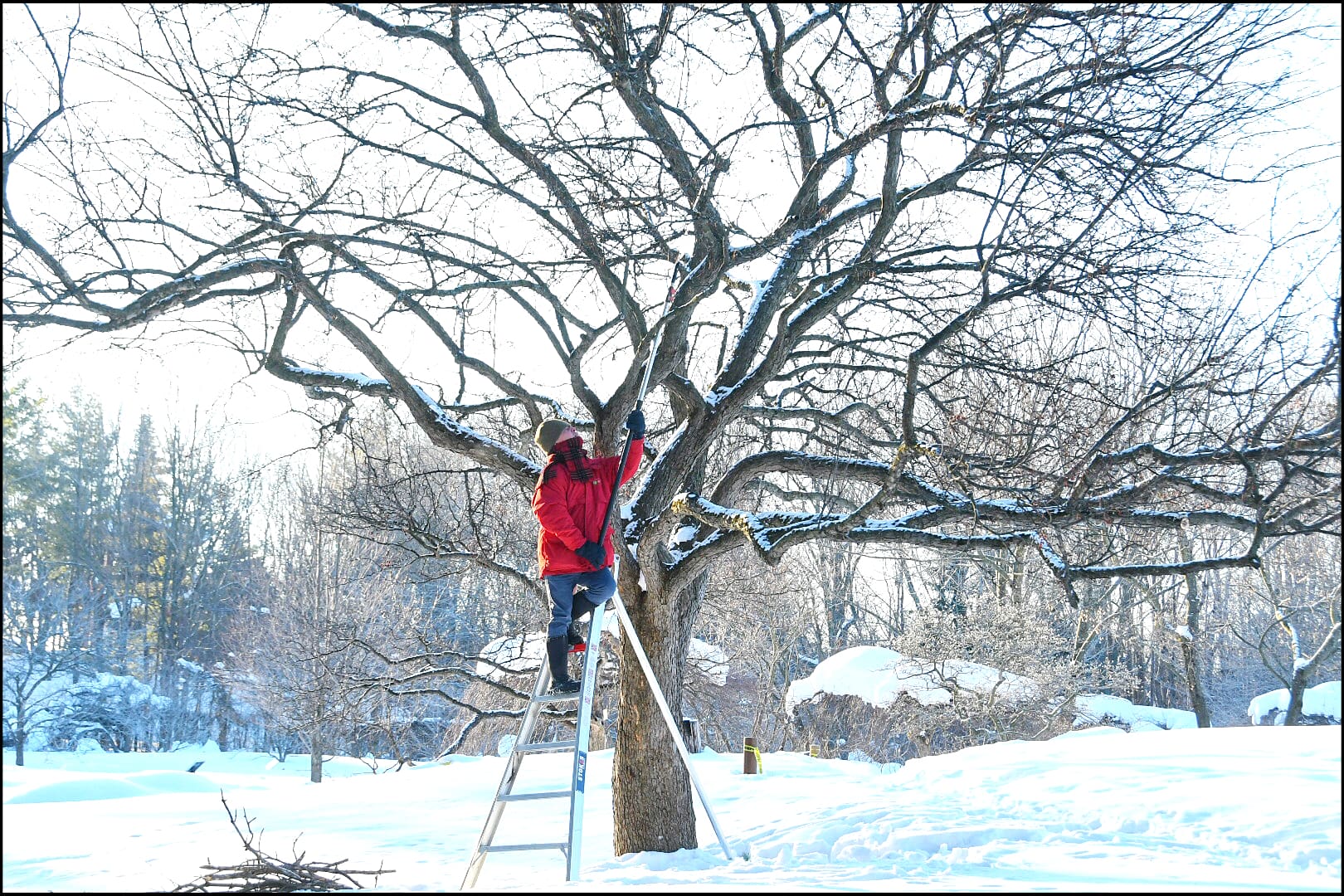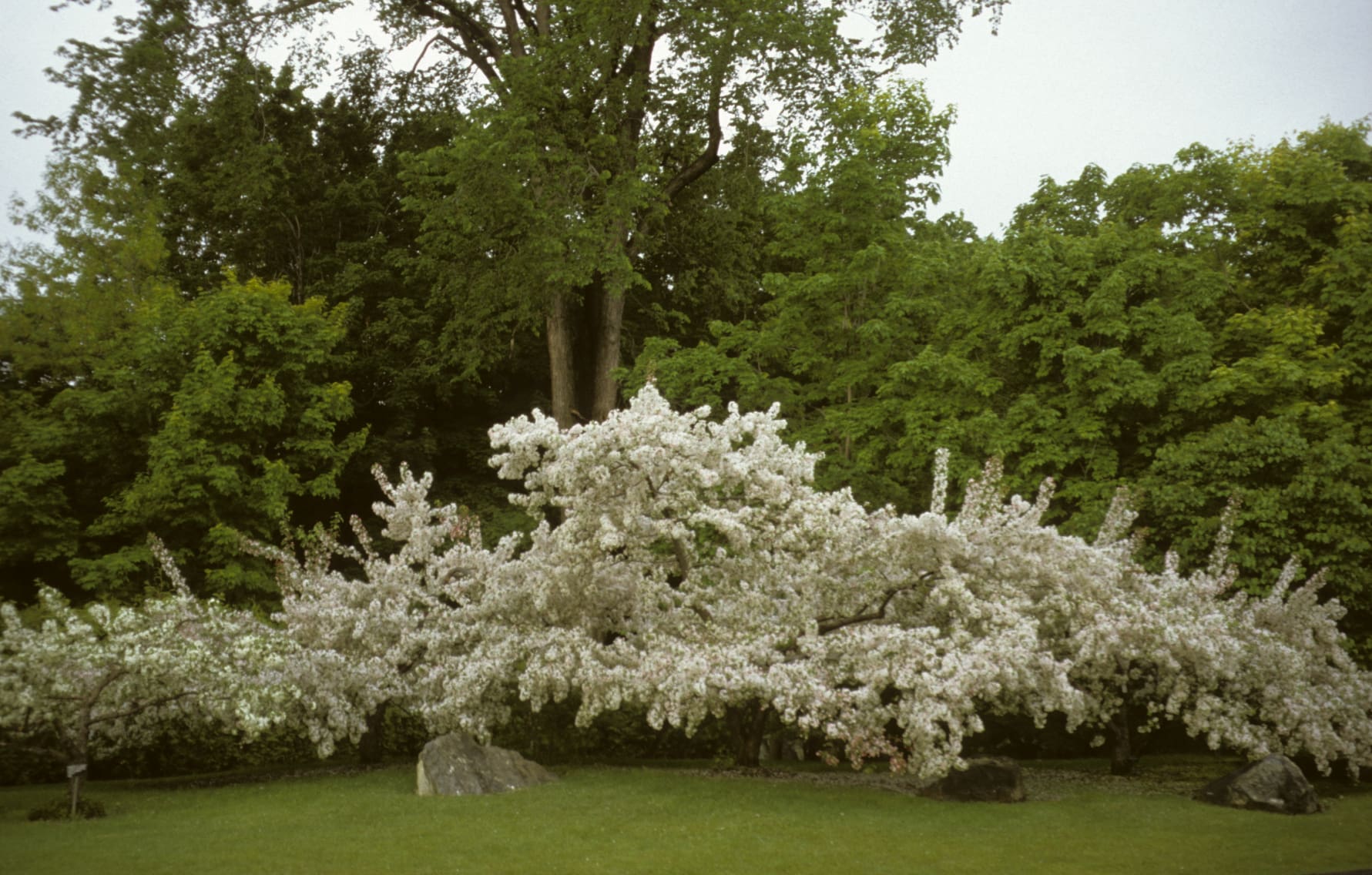Japanese Garden Reference Library
How-to's and Other Resources for Japanese GardensDormant Pruning
By Louis Rinfret
Montreal Botanical Gardens, Horticulture Department
At the Japanese garden of the Montreal Botanical Garden we start pruning when the possibility of severely cold weather has passed. It’s usually by the end of February. We prune while the trees are still dormant. It can be as late as mid April.

Louis pruning at Montreal Botanical Garden. Photo by Mireille Rico
Due to the lack of hardiness of cherry trees like Prunus serrulata and Prunus subhirtella in our northern cold climate, we use crabapples trees as a substitute.
When pruning this type of tree we start by removing suckers and water sprouts. The suckers grow from the rootstock of the tree. If we allow them to develop, they can grow into new trunks, possibly of a completely different tree type. This is because the crabapple was grafted onto the rootstock of a different variety. The removal of suckers can be done at any time of the year.

Blooming Crabapple Tree (last May). Photo by Louis Rinfret.
Water sprouts are small shoots that emerge at an angle between some of the main branches. They don’t usually produce fruit.
The next step in cutting back is to remove any dead branches and increase the space between branches so as to decrease the risk of disease spreading from one branch to another.
Once all of the above is done we proceed to the aesthetic pruning. We remove branches or parts of them to reveal the natural beauty the tree has to offer, making sure that the remaining branches are well-spaced from each other. The spread of disease is more frequent when branches are crowded. We also shorten certain branches in order to control the growth of the tree and to encourage flower buds and eventually fruit.
Besides crabapple trees we do dormant pruning on many other deciduous trees.
*First Picture: Louis pruning at Montreal Botanical Garden. Photo by Mireille Rico.
*Second Picture: Blooming Crabapple Tree (last May). Photo by Louis Rinfret.
Related Content
“The Charm and Challenges of Garden Ponds” – Excerpts from the 2014-2015 NAJGA Journal
The following are excerpts from NAJGA Journal 2014-2015 articles on improving water quality, restoring shorelines and aquatic plants, adding to hardscape, repairing leaks, maintaining historic sensibility and choosing the right construction materials.
7 Common Raking Patterns In Japanese Dry Landscape Gardens
Ready to embark on a journey through Japanese tea houses and tea gardens in North America? Let's uncover their captivating stories together!
A Tour of Moss Gardens in Japan and North America
[pdf-embedder...
Alternate “raking” methods
Don't have a karesansui and want to "rake" the G4P design? If you...
Anderson Japanese Garden in February
By Catherine MarshAnderson Japanese Gardens Although our Gardeners...
Anderson Japanese Gardens’ Cold Weather Challenge
Extreme winter cold guided several construction decisions for the Garden of Reflection pond built in 1999 at Anderson Japanese Gardens in Rockford, Illinois.
At Hillwood Estate, Restoring & Preserving a Vision From the Past
A post-war residential Japanese garden on the estate of heiress Marjorie Merriweather Post in Washington, D.C. was in need of several repairs after 40 years.
Building Your Toolbox
If you are looking to add a few special Japanese gardening tools to...
Care & Feeding of Japanese Tools
Quality gardening tools are an investment and a treasure. Here are a...
Characters in the Japanese Garden
In the last e-newsletter, we discussed plant material options for...
Cherry Blossom Websites
The websites below discuss the importance and symbolism of cherry...
Cherry Diplomacy in US-Japan Relations
Of all the countries in the world, only the United States had a Potomac Park as a show garden for cherries on a scale that resembled the best of the cherry picnic places in Japan. Every spring, the Park revived, and continues to revive a nationwide awareness of the cherries.
Cherry Tree Bloom
[pdf-embedder...
Fall Garden Tour & Pruning Workshop in partnership with APA
Garden Tour - October 25: We will be visiting 4 Japanese style gardens...
Fall Pruning for Japanese Black Pine Trees
Discover expert techniques for pine pruning in our comprehensive guide to fall care for Japanese Black Pine.
Finding A Place For Moss In the Japanese Gardens of North America
The North American Japanese Garden Association (NAJGA) recently talked...
Garden Ponds
In the fall of 2013, the NAJGA Regional Conference, which was held at Shofuso Japanese House and Garden in Philadelphia, focused on ponds: how to build, maintain, and repair them and how to keep koi happy within their waters.
Hot & Cold on Crabapple Pruning
Hazy Summer Crabs A winter coat is the perfect garment for dormant...
Interview with Leslie Buck on Apprenticeship in the Gardens of Kyoto
Leslie Buck, author of Cutting Back: My Apprenticeship in the Gardens of Kyoto, interviewed by Kristin Faurest of the Portland Japanese Garden’s International Japanese Garden Training Center.
Jacarandas in Mexico City
Do you know the story of the jacarandas in México City? Inspired by...
